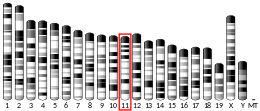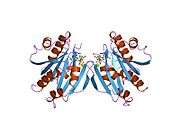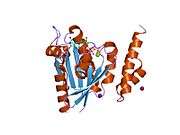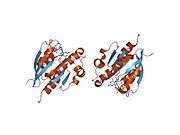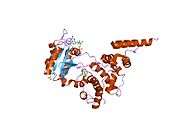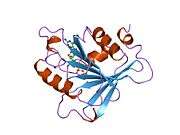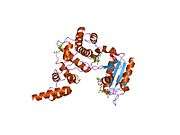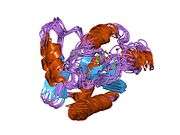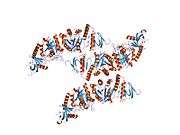ARF1
ADP-ribosylation factor 1 is a protein that in humans is encoded by the ARF1 gene.[5]
Function
ADP-ribosylation factor 1 (ARF1) is a member of the human ARF gene family. The family members encode small guanine nucleotide-binding proteins that stimulate the ADP-ribosyltransferase activity of cholera toxin and play a role in vesicular trafficking as activators of phospholipase D. The gene products, including 6 ARF proteins and 11 ARF-like proteins, constitute a family of the RAS superfamily. The ARF proteins are categorized as class I (ARF1, ARF2 and ARF3), class II (ARF4 and ARF5) and class III (ARF6), and members of each class share a common gene organization. The ARF1 protein is localized to the Golgi apparatus and has a central role in intra-Golgi transport. Multiple alternatively spliced transcript variants encoding the same protein have been found for this gene.[6]
The major mechanism of action of Brefeldin A is through inhibition of ARF1.
Interactions
ARF1 has been shown to interact with:
References
- GRCh38: Ensembl release 89: ENSG00000143761 - Ensembl, May 2017
- GRCm38: Ensembl release 89: ENSMUSG00000048076 - Ensembl, May 2017
- "Human PubMed Reference:". National Center for Biotechnology Information, U.S. National Library of Medicine.
- "Mouse PubMed Reference:". National Center for Biotechnology Information, U.S. National Library of Medicine.
- Lee CM, Haun RS, Tsai SC, Moss J, Vaughan M (June 1992). "Characterization of the human gene encoding ADP-ribosylation factor 1, a guanine nucleotide-binding activator of cholera toxin". J Biol Chem. 267 (13): 9028–34. PMID 1577740.
- "Entrez Gene: ARF1 ADP-ribosylation factor 1".
- Mitchell R, Robertson DN, Holland PJ, Collins D, Lutz EM, Johnson MS (September 2003). "ADP-ribosylation factor-dependent phospholipase D activation by the M3 muscarinic receptor". J. Biol. Chem. 278 (36): 33818–30. doi:10.1074/jbc.M305825200. PMID 12799371.
- Fischer KD, Helms JB, Zhao L, Wieland FT (April 2000). "Site-specific photocrosslinking to probe interactions of Arf1 with proteins involved in budding of COPI vesicles". Methods. 20 (4): 455–64. doi:10.1006/meth.2000.0958. PMID 10720466.
- Eugster A, Frigerio G, Dale M, Duden R (August 2000). "COP I domains required for coatomer integrity, and novel interactions with ARF and ARF-GAP". EMBO J. 19 (15): 3905–17. doi:10.1093/emboj/19.15.3905. PMC 306616. PMID 10921873.
- Dell'Angelica EC, Puertollano R, Mullins C, Aguilar RC, Vargas JD, Hartnell LM, Bonifacino JS (April 2000). "GGAs: a family of ADP ribosylation factor-binding proteins related to adaptors and associated with the Golgi complex". J. Cell Biol. 149 (1): 81–94. doi:10.1083/jcb.149.1.81. PMC 2175099. PMID 10747089.
- Puertollano R, Randazzo PA, Presley JF, Hartnell LM, Bonifacino JS (April 2001). "The GGAs promote ARF-dependent recruitment of clathrin to the TGN". Cell. 105 (1): 93–102. doi:10.1016/s0092-8674(01)00299-9. PMID 11301005.
- Lee S, Park JB, Kim JH, Kim Y, Kim JH, Shin KJ, Lee JS, Ha SH, Suh PG, Ryu SH (July 2001). "Actin directly interacts with phospholipase D, inhibiting its activity". J. Biol. Chem. 276 (30): 28252–60. doi:10.1074/jbc.M008521200. PMID 11373276.
- Park JB, Kim JH, Kim Y, Ha SH, Yoo JS, Du G, Frohman MA, Suh PG, Ryu SH (July 2000). "Cardiac phospholipase D2 localizes to sarcolemmal membranes and is inhibited by alpha-actinin in an ADP-ribosylation factor-reversible manner". J. Biol. Chem. 275 (28): 21295–301. doi:10.1074/jbc.M002463200. PMID 10801846.
Further reading
- Serafini T, Orci L, Amherdt M, et al. (1991). "ADP-ribosylation factor is a subunit of the coat of Golgi-derived COP-coated vesicles: a novel role for a GTP-binding protein". Cell. 67 (2): 239–53. doi:10.1016/0092-8674(91)90176-Y. PMID 1680566.
- Kahn RA, Kern FG, Clark J, et al. (1991). "Human ADP-ribosylation factors. A functionally conserved family of GTP-binding proteins". J. Biol. Chem. 266 (4): 2606–14. PMID 1899243.
- Stearns T, Willingham MC, Botstein D, Kahn RA (1990). "ADP-ribosylation factor is functionally and physically associated with the Golgi complex". Proc. Natl. Acad. Sci. U.S.A. 87 (3): 1238–42. doi:10.1073/pnas.87.3.1238. PMC 53446. PMID 2105501.
- Bobak DA, Nightingale MS, Murtagh JJ, et al. (1989). "Molecular cloning, characterization, and expression of human ADP-ribosylation factors: two guanine nucleotide-dependent activators of cholera toxin". Proc. Natl. Acad. Sci. U.S.A. 86 (16): 6101–5. doi:10.1073/pnas.86.16.6101. PMC 297783. PMID 2474826.
- Greasley SE, Jhoti H, Teahan C, et al. (1995). "The structure of rat ADP-ribosylation factor-1 (ARF-1) complexed to GDP determined from two different crystal forms". Nat. Struct. Biol. 2 (9): 797–806. doi:10.1038/nsb0995-797. PMID 7552752.
- Welsh CF, Moss J, Vaughan M (1995). "ADP-ribosylation factors: a family of approximately 20-kDa guanine nucleotide-binding proteins that activate cholera toxin". Mol. Cell. Biochem. 138 (1–2): 157–66. doi:10.1007/BF00928458. PMID 7898460.
- Greasley S, Jhoti H, Fensome AC, et al. (1995). "Crystallization and preliminary X-ray diffraction studies on ADP-ribosylation factor 1". J. Mol. Biol. 244 (5): 651–3. doi:10.1006/jmbi.1994.1759. PMID 7990146.
- Amor JC, Harrison DH, Kahn RA, Ringe D (1994). "Structure of the human ADP-ribosylation factor 1 complexed with GDP". Nature. 372 (6507): 704–8. doi:10.1038/372704a0. PMID 7990966.
- Dascher C, Balch WE (1994). "Dominant inhibitory mutants of ARF1 block endoplasmic reticulum to Golgi transport and trigger disassembly of the Golgi apparatus". J. Biol. Chem. 269 (2): 1437–48. PMID 8288610.
- Rümenapp U, Geiszt M, Wahn F, et al. (1996). "Evidence for ADP-ribosylation-factor-mediated activation of phospholipase D by m3 muscarinic acetylcholine receptor". Eur. J. Biochem. 234 (1): 240–4. doi:10.1111/j.1432-1033.1995.240_c.x. PMID 8529647.
- Andersson B, Wentland MA, Ricafrente JY, et al. (1996). "A "double adaptor" method for improved shotgun library construction". Anal. Biochem. 236 (1): 107–13. doi:10.1006/abio.1996.0138. PMID 8619474.
- Hirai M, Kusuda J, Hashimoto K (1997). "Assignment of human ADP ribosylation factor (ARF) genes ARF1 and ARF3 to chromosomes 1q42 and 12q13, respectively". Genomics. 34 (2): 263–5. doi:10.1006/geno.1996.0283. PMID 8661066.
- Kanoh H, Williger BT, Exton JH (1997). "Arfaptin 1, a putative cytosolic target protein of ADP-ribosylation factor, is recruited to Golgi membranes". J. Biol. Chem. 272 (9): 5421–9. doi:10.1074/jbc.272.9.5421. PMID 9038142.
- Yu W, Andersson B, Worley KC, et al. (1997). "Large-scale concatenation cDNA sequencing". Genome Res. 7 (4): 353–8. doi:10.1101/gr.7.4.353. PMC 139146. PMID 9110174.
- Shome K, Vasudevan C, Romero G (1997). "ARF proteins mediate insulin-dependent activation of phospholipase D". Curr. Biol. 7 (6): 387–96. doi:10.1016/S0960-9822(06)00186-2. PMID 9197239.
- Frank S, Upender S, Hansen SH, Casanova JE (1998). "ARNO is a guanine nucleotide exchange factor for ADP-ribosylation factor 6". J. Biol. Chem. 273 (1): 23–7. doi:10.1074/jbc.273.1.23. PMID 9417041.
- Betz SF, Schnuchel A, Wang H, et al. (1998). "Solution structure of the cytohesin-1 (B2-1) Sec7 domain and its interaction with the GTPase ADP ribosylation factor 1". Proc. Natl. Acad. Sci. U.S.A. 95 (14): 7909–14. doi:10.1073/pnas.95.14.7909. PMC 20903. PMID 9653114.
- Kim JH, Lee SD, Han JM, et al. (1998). "Activation of phospholipase D1 by direct interaction with ADP-ribosylation factor 1 and RalA". FEBS Lett. 430 (3): 231–5. doi:10.1016/S0014-5793(98)00661-9. PMID 9688545.
- Huber I, Cukierman E, Rotman M, et al. (1998). "Requirement for both the amino-terminal catalytic domain and a noncatalytic domain for in vivo activity of ADP-ribosylation factor GTPase-activating protein". J. Biol. Chem. 273 (38): 24786–91. doi:10.1074/jbc.273.38.24786. PMID 9733781.



